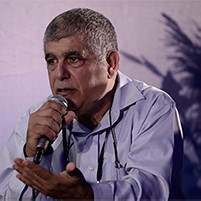
The analysis discusses the strategic shift in the Middle East conflict, where Israel faces a multi-front war orchestrated by Iran through its regional proxies, highlighting the factors that could influence the expansion of the Gaza conflict into a wider regional war.
A preliminary analysis of the online far-right’s response to the Israel-Hamas conflict.
A preliminary analysis of the surprise terror attack by Hamas from Gaza against Israel on 07 October 2023.
This analysis focuses on the increased threats and calls for violence against Israelis and Jews globally, particularly in the context of the campaign in Gaza and Hamas’ actions.
A preliminary analysis reviewing the sophisticated media campaign deployed by Hamas prior to and throughout this ongoing conflict.
A preliminary analysis of the Anonymous Sudan pro-Islamic hacker group initiating a cryptocurrency donation campaign.

The useful idiots on American campuses – opinion
The problem of modern antisemitism, will not go away as long as there is a large number of academics worldwide promoting anti-Israeli narratives and inciting hostility.
Israel Was Prepared for a Different War
The Israeli military’s focus on intelligence, air power and technology left it vulnerable to a low-tech ground assault.
Israel Must Destroy Hamas’s Tunnels
Demolishing the group’s infrastructure is more important than eliminating its leaders.
Twitter’s obligation during crisis and war – opinion
It is incumbent on Elon Musk to ensure that Twitter does not incentivize antisemitic viewpoints and conspiracy theories.

What is Hamas and what are its goals?
Hamas is a Palestinian hybrid terrorist organization founded in 1987. After the Israeli withdrawal from the Gaza Strip, Hamas took control as the governing authority. Its primary goals include the establishment of an independent Islamic state, resistance against the Israeli state, and the promotion of Islamic rule in the region.
What is a "hybrid" terror organization?
A hybrid terror organization is a terror organization that is comprised of more than one “wing.” These wings each operate under the guidance of a central governing body. While each “wing” may be differentiated by the type of activities that it engages in (e.g., political wing, military wing, social-welfare wing), all of the individual sections are subordinate to the terrorist organization leadership and support the terror activities of the organization.
Examples of hybrid terror organizations are Hamas and Hezbollah.
How does Hamas differ from other Palestinian groups?
Hamas is distinct from other Palestinian groups like Fatah due to its Islamist ideology, social services network, and refusal to recognize Israel’s right to exist. This has led to Hamas’s continued attempts to destabilize the state and harm civilians.
Why does Hamas use rocket attacks against Israel?
Hamas employs rocket attacks as a means of resistance against the continued existence of the State of Israel. These attacks are often used to exert pressure on Israel, draw international attention, or seek concessions.
Is Hamas a terrorist organization?
Hamas is a terrorist organization. While the organization portray’s itself as having two separate wings, a military and political, the actions of the political wing are meant to support the activities of the military wing. As such, many states including Israel, the United States, Australia, Japan, the United Kingdom, and the European Union have designated it as a terrorist organization.
Unfortunately, many other states continue to only designate the military wing as a terrorist.
What are the implications of Hamas being labeled a terrorist organization by some countries?
The designation of Hamas as a terrorist organization by some countries restricts its ability to engage in international diplomacy and financial transactions. When some countries still do not fully designate the organization, it is able to continue operating and supporting its terror activities.
How does Hamas govern the Gaza Strip, and what is life like under its rule?
Hamas governs the Gaza Strip with its own institutions and enforces strict Islamic laws, creating a complex socio-political landscape. Life under its rule has been marked by significant challenges, including limited access to basic resources, economic hardships, and restrictions on personal freedoms. Armed groups within the territory also contribute to an environment of instability and insecurity. Gaza residents often struggle to access healthcare, education, and job opportunities, making life under Hamas governance particularly challenging.
What is Hezbollah and what are its goals?
Hezbollah, also known as the “Party of God,” is a Lebanese Shia Islamist militant and political organization.
Hezbollah was formulated in 1982 based on Ayatollah Ruhollah Khomeini’s ideology spread in 1979 during the Islamic Revolution in Iran.
According to its ideology, Israel is the “Little Satan”, it has no right to exist and efforts need to be made to physically wipe it out. The US is the ” Great Satan”.
What is a "hybrid" terror organization?
A hybrid terror organization is a terror organization that is comprised of more than one “wing.” These wings each operate under the guidance of a central governing body. While each “wing” may be differentiated by the type of activities that it engages in (e.g., political wing, military wing, social-welfare wing), all of the individual sections are subordinate to the terrorist organization leadership and support the terror activities of the organization.
As for Hezbollah, its three wings (military-terrorist, social warfare wing, and political wing) operate synergistically, enabling Hezbollah to present an appearance of a legitimate and pragmatic Lebanese political party working to defend Lebanon.
Unlike other terrorist organizations, Hezbollah does not view itself as a separate unit, the contrary. On various occasions, its leaders clearly stated that Hezbollah is a hierarchical organization operating as a single entity under the leadership of the Shura Council, led by Hassan Nasrallah.
Is Hezbollah a terrorist organization?
Yes, Hezbollah is a terrorist organization. Countries that designated Hezbollah as a terrorist organization include Israel, the United States, Canada, The United Kingdom, Germany, the Netherlands, the EU, Bahrain, the Gulf Cooperation Council (GCC), The Arab League, Argentina and others.
Unfortunately, some countries and organizations distinct between Hezbollah’s political-social wing and its military-terrorist wing and only designate the military wing as a terrorist entity.
What are the implications of Hezbollah being labeled a terrorist organization by some countries?
The failure to define the entire organization as a terrorist organization or its partial designation by certain countries plays into Hezbollah’s hands. Instead of restricting its ability to engage in international diplomacy and financial transactions, the organization continues operating its terror activities.
What is the role of Hezbollah in the Lebanese politics?
Hezbollah is part of the “March 8” Alliance, which has the majority of members of parliament and holds the most important portfolios in the Lebanese government.
Specifically, Hezbollah’s representation in the parliament is relatively small but has a massive influence on Lebanese politics due to the existence of its military wing, which poses a threat to those who oppose the organization.
Did the Hezbollah's involvement in Lebanese politics cause a decline in its illegal activity?
Absolutely not. Hezbollah is part of the Lebanese government but operates primarily outside the framework of the law, being involved in corruption on a particularly large scale compared to other actors in the Lebanese system. Also, Hezbollah is much involved in crime; Hezbollah operates an international network of drugs and crime.
Hezbollah has dragged Lebanon into violent turbulence, leading to the destruction of infrastructure, harming the Lebanese economy, and led the loss of human lives, contradicting the interests of the Lebanese government and the public.
What is the nature of the relationship between Iran and Hezbollah?
Hezbollah is the long arm of Iran. There is a reciprocal relationship between Iran and Hezbollah. On the one hand, Iran supports Hezbollah’s activities in the regional and international arena. On the other hand, Hezbollah works to advance Iran’s interests. Iran has increased its support for the organization over the years, providing financing, operational support, and more.
Is Hezbollah's activity focused only on Israel?
No, Hezbollah is a destabilizing actor in the local, regional, and international arena. Hezbollah operates a worldwide terrorist as well as social infrastructure. Not only does Hezbollah pose a physical threat by carrying out terrorist attacks, but it is also involved in arms trade, crime, terror finance, and more. Hezbollah’s social activities enable it to strengthen its ideological support and mobilize new members.
For example, the US Cassandra Operation against Hezbollah’s funding from illicit drug sources revealed a well-established infrastructure in Europe (Germany, Belgium, France, Cyprus, Bulgaria, Italy, the Czech Republic, the UK, and more).
What is in Hezbollah's arsenal?
It is estimated that Hezbollah has around 150,000 missiles, rockets, and mortars (short, mid, and long-range), including guided missiles. Hezbollah also owns different kinds of shore-to-ship missiles as well as anti-tank missiles and anti-aircraft missiles.
Hezbollah has hundreds of remotely controlled aircraft, varying from intelligence-gathering drones to attack aircraft.
Hezbollah’s personnel is estimated in approx. 45,000 operatives. Its elite unit, the Radwan Force of approximately 2,500 operatives, has a primary mission to infiltrate Israeli territory to conquer the Galilee.






























